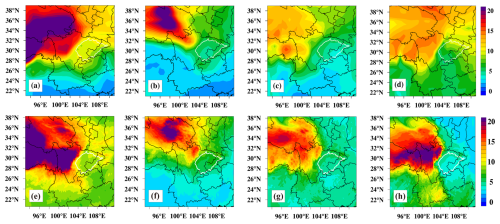the Creative Commons Attribution 4.0 License.
the Creative Commons Attribution 4.0 License.
Impact of stratospheric intrusion on near-surface ozone over the Sichuan Basin in China driven by terrain forcing of Tibetan Plateau
Zhuozhi Shu
Fumo Yang
Guangming Shi
Yuqing Zhang
Yongjie Huang
Xinning Yu
Baiwan Pan
Tianliang Zhao
Stratospheric ozone (O3) intrusion acts as a major natural source of tropospheric O3 affecting atmospheric environment. Targeting a stratospheric intrusion (SI) hotspot, the Tibetan Plateau (TP) with the immediately adjoining O3 pollution region of Sichuan Basin (SCB) in Southwest China, this study assesses the contribution of SI to the near-surface O3 over SCB and reveals the multi-scale coupling mechanisms of atmospheric circulations with the seasonally discrepant terrain effects of the TP. Based on the simulations on four selected SI events in 2017, it is estimated that SI over the TP can penetrate deeply into the near-surface atmosphere in SCB, with event-specific maxima of up to 38.7 % in O3 increments, providing an extra contribution of 11.1 %–16.0 % to regional O3 pollution. The evolution of South Asian High in the upper troposphere with the peripheral subsidence in the warm seasons and the subtropical westerly jet over the TP in the cold seasons facilitates tropopause folding, driving stratospheric O3 into the free troposphere. We further identified the dominant processes for SI-derived O3 entering the near-surface layer over the basin with (1) a direct intrusion pathway of downward transport over the central and eastern SCB regions in the warm seasons, and (2) an indirect pathway of downslope transport along the TP-SCB slope into the western SCB region in the cold season, revealing the distinct seasonal effects of TP thermal and mechanical forcing on stratospheric O3 transport into the SCB region. These findings highlight the critical role of the TP in modulating stratosphere-to-troposphere O3 transport and its implications for regional air quality changes.
- Article
(14726 KB) - Full-text XML
-
Supplement
(1499 KB) - BibTeX
- EndNote
Ozone (O3) is a crucial atmospheric chemical composition. Stratospheric O3 (accounting for approximately 90 % of the O3 column) can absorb harmful ultraviolet radiation and protect the surface biosphere, while tropospheric O3 has emerged as one of the most important air pollutants due to its direct impact on climate change, ecosystem, atmospheric oxidation and human health (Fiore et al., 2002; Feng et al., 2015; Miri et al., 2016). Tropospheric O3 mainly originates from photochemical production and stratospheric intrusion. The former is characterized by complex nonlinear reactions of O3 precursors from anthropogenic and natural emissions, involving carbon monoxide, volatile organic compounds and nitrogen oxides, etc. In comparison, the downward transport of stratospheric O3 not only provides an additional natural source for tropospheric O3 budgets but causes uncertainties in the near-surface atmospheric environmental changes (Lin et al., 2012; Monks et al., 2015; Liu et al., 2022).
Stratospheric intrusion (SI) is an atmospheric dynamic process occurring between the lower stratosphere and upper troposphere, characterized by the cross-tropopause transport of stratospheric dry airflows into troposphere with rich O3 and high-level potential vorticity. Multi-scale atmospheric physical processes can trigger SI, including Brewer–Dobson circulation (Brewer, 1949; Dobson, 1956; Butchart, 2014), Rossby wave breaking, ENSO, subtropical jet stream, cut-off low, mesoscale convection, and tropopause folding (Waugh and Polvani, 2000; Sprenger et al., 2003; Nieto et al., 2005; Koumoutsaris et al., 2008; Trickl et al., 2011; Neu et al., 2014; Venkat Ratnam et al., 2016). Approximately 540 ± 140 Tg yr−1 stratospheric O3 enters the troposphere through SI worldwide, contributing ∼ 30 % of the tropospheric O3 column (Stohl et al., 2003; Naik et al., 2013). Global SI distribution exhibits a distinct zonal and seasonal asymmetry where the SI hotspots are located in the subtropical regions during late winter and early spring (Škerlak et al., 2014; Williams et al., 2019). The peak of tropopause folding frequency in the period even induces deep SI affecting the lower troposphere (Trickl et al., 2014; Zhao et al., 2021; Chen et al., 2023) which leads to the “exceptional events” on air quality changes (Lin et al., 2015; Pierce and Holloway, 2017). Therefore, cross-layer transport of stratospheric O3 has a non-negligible potential impact on the near-surface ambient atmosphere, especially over the susceptive regions of SI (e.g. the west coast of North America, Northwest coast of Africa, eastern Mediterranean and Tibetan Plateau) (Škerlak et al., 2015; Lee et al., 2024).
Tibetan Plateau (TP) is the highest plateau referred as “the roof of the world”, located in the mid-latitude region over the Eurasian continent. Large-topography forcing not only modulates hemispheric-scale atmospheric circulation patterns but forms a key window of mass exchange between stratosphere and troposphere (Fu et al., 2006; Li et al., 2018; Huang et al., 2023). As a global hotspot for SI (Škerlak et al., 2014), the impacts of SI on tropospheric O3 over TP have been extensively studied in recent years. Previous results pointed out that the subtropical jet stream is the principal driving factor for frequent SI events over the TP (Zhang et al., 2010; Luo et al., 2019), dominating the vertical distribution of tropospheric O3 (Yang et al., 2022; Yin et al., 2023). The O3-rich airflows from SI can subsequently extend downward to the deep planetary boundary layer by intense turbulent mixing (Chen et al., 2011; Chou et al., 2023), remarkably affecting seasonal and diurnal variations of near-surface O3 in the region (Ding and Wang, 2006; Ma et al., 2014; Yin et al., 2017). However, with the distinct topography of TP and frequent SI occurrence, few studies consider the impacts of residual O3-rich from SI on atmospheric environmental changes over downstream regions of westerlies, particularly in the typical pollution regions. Addressing this gap, further exploring the impacts of cross-layer O3 transport from the free troposphere on atmospheric environmental changes in the flat region under the mid-latitude prevailing westerlies is of great value.
Sichuan Basin (SCB), located immediately adjacent to the eastern TP, is recognized as a key region of air pollution complex in China (Lu et al., 2018; Wang et al., 2022) with persistently elevated near-surface O3 levels (Wei et al., 2022). Regarding the frequent O3 pollution in SCB, extensive research focuses on the meteorology-emission synergy effects on atmospheric environmental variability, including photochemical regime (Kong et al., 2023), horizontal transport and residual layer mixing (Shu et al., 2023; Wang et al., 2024) and biological source contribution (Xian et al., 2024). Notably, subsidence momentum in the middle and lower free troposphere coexists with the forced uplift of the East Asian monsoon over SCB, ascribed to mechanical forcing of TP's terrain on prevailing airflows (Xu et al., 2016; Shu et al., 2022), which significantly enhance the vertical interactions of atmospheric pollutants between the free troposphere and atmospheric boundary layer (Shu et al., 2021; Hu et al., 2022). Such regional vertical circulation patterns create excellent atmospheric dynamical conditions for SI to affect the ambient atmosphere over SCB. Therefore, investigating the multi-scale atmospheric circulation coupling mechanisms for stratospheric O3 into the ambient atmosphere under the plateau-basin topography can provide critical insights into understanding the uncertainty of O3 pollution in China.
In this study, we aim to quantify the contribution of SI to near-surface O3 levels over the SCB and then to elucidate the multi-scale circulation coupling mechanisms, in particular focusing on their seasonality with the thermodynamic and dynamical forcing of TP and SCB. The findings of our study are expected to improve the understanding of atmospheric environmental effects of the TP with implications for global and regional environmental changes. Section 2 introduces the observational and reanalysis data, SI episodes selection, WRF-Chem model configuration, experiment design and modeling evaluation results. Section 3 analyzes the temporospatial variations of SIs' impacts on the near-surface layer over the SCB and the terrain-induced atmospheric circulation mechanisms on cross-layer transport of O3 from stratosphere into the atmospheric boundary layer. Finally, the conclusions are provided in Sect. 4.
2.1 Observational and reanalysis data
The hourly ground-based observations of environment and meteorology (near-surface O3 concentrations, 2 m air temperature (T2), 10 m wind speed (WS10) and near-surface relative humidity (RH)) in the study region are respectively obtained from the China National Environmental Monitoring Center (http://www.cnemc.cn/last access: 5 November 2025) and the Chinese Meteorological Monitoring Network (http://data.cma.cn/last access: 5 November 2025) to evaluate WRF-Chem model performance during the SI episodes.
The hourly 3D meteorological reanalysis data ERA5, with a horizontal resolution of 0.25° × 0.25°, are derived from the European Center for Medium-Range Weather Forecasts (https://cds.climate.copernicus.eu/datasets, last access: 5 November 2025). In the study, this dataset is not only used for SI identification and atmospheric circulation evolution analysis but also serves as the initial and boundary conditions of WRF-Chem experiments. Additionally, the Copernicus Atmosphere Monitoring Service (CAMS) global atmospheric composition reanalysis dataset EAC4 (https://ads.atmosphere.copernicus.eu/datasets, last access: 5 November 2025) provides 3-hourly chemical species data with a horizontal resolution of 0.75° × 0.75° and 60 vertical layers, presenting great credibility in the environment-chemistry field (Inness et al., 2019). The stratospheric O3 tracer (O3S) from EAC4 is utilized to verify WRF-Chem simulation applicability for quantifying the transport contributions of SI.
2.2 Selection of seasonal SI episodes
The months of April, July, October and January in the year 2017 are chosen to characterize seasonal variations in SI and atmospheric circulation patterns in the study as a sequel to our previous studies (Shu et al., 2022, 2023). Corresponding pressure-time cross sections of O3 averaged over the regions of eastern TP (90–100° E, 28–33° N) and SCB (103–110° E, 28–33° N) are shown in Fig. 1. It is found that frequent stratospheric O3 intrusions appear over the eastern TP region and significantly affects the middle troposphere with deep SI during April and January but shallow SI in the months of July and October, which is consistent with SI seasonality in the previous results (Škerlak et al., 2014; Luo et al., 2019). With the middle-latitude westerlies transport, the O3-rich air from SI is stretched and deepens into the lower troposphere (reaching 700 hPa layer) over the SCB. In this study, four SI events are selected based on vertical O3 structures over the eastern TP and SCB, prioritizing peak SI intensity and significant impacts on the lower-tropospheric O3 concentrations. The strongest-impact cases within their respective months occurring during 12–17 April (EP1), 1–3 July (EP2), 23–28 October (EP3), and 26–30 January (EP4) (Fig. 1) serve as typical seasonal representatives. Their selection enables clear elucidation of seasonal atmospheric circulation background and quantitative O3 contributions to near-surface pollution.
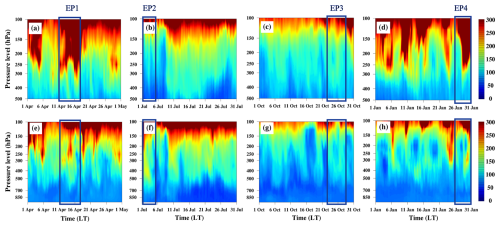
Figure 1Vertical-time cross sections of O3 mixing ratio (ppb) over the TP (a–d) and SCB (e–h) during April (a, e), July (b, f), October (c, g) and January (d, h) in 2017. The dark-blue boxes respectively represent the selected four SI episodes (EP1–EP4).
Tropopause folding frequently occurs in the TP characterized by perturbance in the dynamical tropopause (2 PVU, potential vorticity unit) isosurface associated with downward cross-tropopause exchange (Sprenger et al., 2003; Luo et al., 2019). As shown in Fig. 2, there exist tropopause folding phenomena that induce O3-rich stratospheric airflows injected into the free troposphere between 28 and 34° N in the study period. Notably, the intensity and location of SIs are influenced by the distinct seasonality of vertical motion in the atmosphere. While alternating rising and sinking momentum leads to a deep SI event over the central TP during EP1, the deep convection of TP in EP2 triggers strong stratospheric O3 transport into the lower troposphere (exceeding 160 ppb at 700 hPa layer) over the TP's downstream SCB region. By comparison, a similar vertical structure of SIs in both EP3 and EP4 is featured with the shallow tropopause folding which happens above 300 hPa with weak downward transport of stratospheric O3.
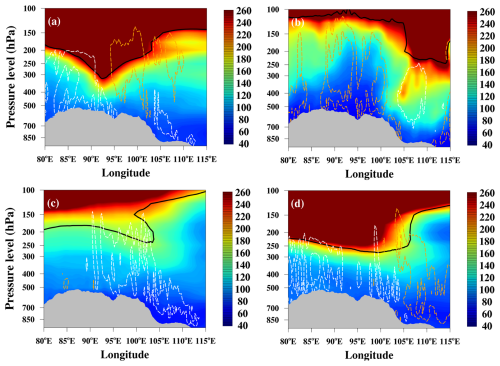
Figure 2Height-longitude cross sections of O3 mixing ratio (ppb) averaged between 28 and 34° N on (a) 15 April, (b) 1 July, (c) 26 October and (d) 28 January in 2017. The black lines indicate tropopause heights (2 PVU) with the updrafts (brown dashed lines) and downdrafts (white dashed lines) in the region.
2.3 Model configuration and experimental design
The fully online weather-chemistry coupled model WRF-Chem (version 3.8.1) is employed to simulate the variations of meteorology and O3 for this study. Three nesting domains are constructed (shown in Fig. S1 in the Supplement) with horizontal model grid intervals respectively of 48, 12, and 3 km and 40 vertical levels from the surface layer to model top at 50 hPa. The first 3 d of simulation are the spin-up time to fully depict SI processes driven by atmospheric circulations. The main physical and chemical schemes are listed in Table S1 in the Supplement. Anthropogenic air pollutant emissions are obtained from the Multi-resolution Emission Inventory for China (version 2017) with a horizontal resolution of 0.25 ° × 0.25° (http://www.meicmodel.org/, last access: 5 November 2025). And the Model of Emissions of Gases and Aerosols from Nature (MEGAN, v2.1, Guenther et al., 2012) is applied for biogenic emissions in the WRF-Chem simulation.
The Upper Boundary Condition (UBC) developed by Barth et al. (2012) is incorporated to revise the values of stratospheric atmospheric chemical species ranging from the tropopause to 50 hPa due to the lack of stratospheric chemistry in WRF-Chem model. The key chemical species (ie., CH4, CO, O3, NO, NO2, HNO3, N2O5 and N2O) are fixed to climatological values from global chemistry model results while the tropopause height is calculated by WACCM results (Barth et al., 2012; Lamarque et al., 2012). Zhao et al. (2021) have proved that WRF-Chem can accurately capture the O3 transport of SI by utilizing UBC scheme. In addition, the integrated process rate (IPR) analysis is used to deepen the understanding of cross-layer O3 transport mechanisms between the free troposphere and atmospheric boundary layer.
Four groups of simulation experiments are conducted to investigate the impact of SI on atmospheric environmental changes over SCB and related plateau-basin terrain forcing effects as follows: (1) Base experiment (Base), utilize UBC scheme to reproduce 3D meteorology and chemistry during the SI episodes; (2) stratospheric O3 sensitivity experiment (EXPstro3), other settings are identical to Base but discard UBC scheme and default O3 values (set as zero) above tropopause in WRF-Chem simulation; (3) the basin-terrain sensitivity experiment (EXPterr), basin-filling terrain replace the default deep-basin terrain height (take Base as a benchmark), which refers to a zonal linear interpolation method (Zhang et al., 2019), but remain surface static fields (e.g. landuse and soil types) unchanged; (4) both stratospheric O3 and basin-terrain sensitivity experiment (EXPstro3+terr), run with basin-filling terrain compared with EXPstro3. To elaborately quantify the contribution of SI in the study, we calculate the relative contributions derived as RC = 100 %, where Δx is the simulation differences between Base and EXPstro3 experiments (Δx = Base − EXPstro3), and Base is the baseline experiment simulations for O3 concentrations, horizontal transport (ADVH) and vertical transport (ADVZ). The O3basin = EXPterr − EXPstro3+terr is used to investigate the deep-basin terrain forcing mechanism on cross-layer transport of O3 during the SI episodes.
2.4 Modeling evaluation
Our model results can reasonably reproduce the variations in meteorology both at the near-surface layer and within atmospheric boundary layer by comparing simulated and observed results during the 4 representative months of April, July, October and January in 2017 (Shu et al., 2023). The statistical metrics of T2, WS10 and RH are also listed in Table S2, which meet the model criteria for applications recommended by Emery et al. (2001).
Regarding the accuracy of simulated surface O3 concentrations, WRF-Chem simulation results also show a good agreement with ground-based environmental observation at 18 urban sites in the SCB (Shu et al., 2023). Fig. S2 shows the comparisons of near-surface O3 variations between simulation and observation at two representative megacities of Chengdu and Chongqing during the SI episodes, respectively with the index of agreement (IOA) of 0.68–0.91 (Chengdu) and 0.56–0.89 (Chongqing) and mean fractional error (MFE) ranged of 10.8 %–20.8 % and 18.9 %–29.7 %. Whereafter, the spatial distribution of near-surface O3 is compared with O3S of EAC4 reanalysis data. As shown in Fig. 3, though there exists an overestimation in EP4, the modeling results properly present the impacts of SI on near-surface O3 levels in our study region. Overall, the evaluation results above present good modeling reliability for the following analyses (Fig. S3).
3.1 Impacts of SI on near-surface O3 levels over the SCB
To illustrate the impacts of SIs on ambient environment, the temporospatial variations of O3 (referring to the difference in O3 between the Base and EXPstro3 experiments) in the near-surface layer are analyzed for SCB and the surrounding regions, based on the WRF-Chem simulation results of the innest domain. The ambient atmosphere of high-elevation regions is significantly influenced by O3-rich stratosphere airflows when the SI episode happens (Bracci et al., 2012; Yin et al., 2017). A similar spatial distribution pattern of O3 presents that SI aggravates O3 levels in the near-surface ambient atmosphere over Southwest China with higher O3 enhancements (exceeding 16 ppb) in the eastern TP rather than lower levels (approximately 6 ppb) over the SCB in all episodes (Fig. 4). Obviously, these results show the plateau-basin topography effects on O3 distribution over the region, and even confirm the connection between air quality changes in the adjoining polluted region of SCB and SI episodes occurring over the TP and surrounding area. Aiming at the SCB region, SI-induced near-surface O3 increments exhibit higher values during EP1 in springtime and lower values in EP4 of wintertime with a significant extension gradient of O3 levels at the western boundary. The phenomena involve downward O3 transport for SI from TP to SCB with prevailing westerlies under the distinctive terrain forcing, which will be further investigated in Sect. 3.2.
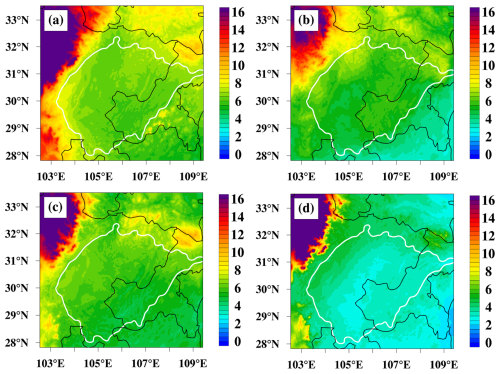
Figure 4Spatial distribution of near-surface O3 (ppb, color contours) during SI events (a) EP1, (b) EP2, (c) EP3 and (d) EP4. The thick white lines roughly outline the SCB region.
To assess the impacts of SI transport on atmospheric environmental changes over the SCB, we calculate the hourly concentrations of O3 and its relative contribution rate (RC) to near-surface O3 levels averaged in the region with the altitudes at 750 m above sea level (white line in Fig. 4). As shown in Fig. 5, stratospheric O3 transport affects the SCB region during the periods of 13–17 April, 1–3 July, 26–28 October and 29–30 January, with the averaged near-surface O3 enhancements of 6.3, 5.5, 4.3, and 3.1 ppb, contributing 18.2 %, 15.4 %, 12.7 % and 17.0 % to regional near-surface O3 concentrations. It should be pointed out that there exist two SI episodes that happened in the TP during our study period of EP1 respectively on 11 and 15 April (Fig. 1), leading to persistent O3 transport contribution for SI during 13–18 April over the SCB. A diurnal fluctuation appears in the SI episodes with higher O3 levels in the daytime and lower levels during the nighttime, reflecting the impacts of vertical mixing within atmospheric boundary layer on downward O3 transport.
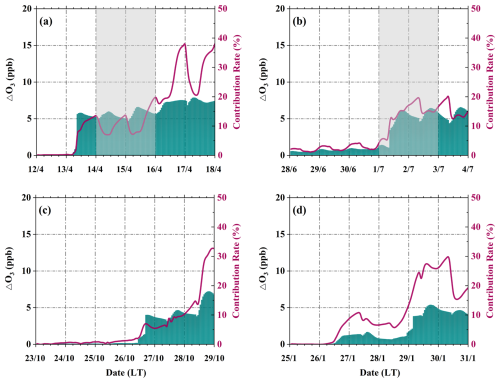
Figure 5Hourly variations of near-surface O3 (ppb, blue-filled areas) during the period of SI events (a) EP1, (b) EP2, (c) EP3 and (d) EP4 with their relative contribution proportions (RC) to the ambient atmosphere (dark red curve) averaged over the SCB. The gray shade indicates the regional O3 pollution period.
The East Asian monsoons significantly modulate the seasonality of near-surface O3 over the SCB region, leading to high O3 levels and frequent pollution during the summer monsoon period (April–July) to low levels over the winter monsoon period (October–January) (Gao et al., 2020; Wang et al., 2022). It is noteworthy that the SCB experiences O3 pollution during the EP1 and EP2 episodes. As shown in Fig. S4, the site-observed near-surface O3 concentrations averaged over SCB are respectively 152.8 µm m−3 for EP1 episode and 157.8 µm m−3 for EP2 episode with peaks of daily maximum 8 h average O3 concentrations of 219.0 and 233.6 µm m−3. The O3 of SI induces O3 pollution aggravation in the SCB with an extra contribution of approximately 11.1 %–16.0 %. Previous studies indicate that the unique topography of SCB amplifies the synergy effects of meteorology and emission on photochemical O3 formation, dominating regional near-surface O3 pollution (Yang et al., 2020; Xu et al., 2025; Wei et al., 2025). In this case study, we find the contribution of SI to near-surface O3 levels is comparable to that from transboundary transport of tropospheric O3 (Shen et al., 2022), highlighting the non-negligible impact of SI on SCB's atmospheric environment and thereby deserve more concern on the control of air pollution in the region.
We acknowledge that quantifying SI contributions based on four case studies imposes inherent limitations in generalizability. While these events reveal significant SI impacts on regional air quality changes, future multi-year analyses integrating climatological SI frequencies are needed in further study on the SI contributions derived from observations and simulations.
3.2 Terrain-forced atmospheric circulations driving downward transport of stratospheric O3
Now that the impacts of SI on near-surface O3 levels over the SCB have been estimated above, we further address the question of how atmospheric circulations persistently drive airflows descent across the tropopause and atmospheric boundary layer simultaneously. In particular, the seasonal variations in large-scale topography thermodynamic and mechanical forcing of TP and SCB affect multi-scale atmospheric circulation coupling, establishing unique transport pathways from the stratosphere to near-surface atmosphere of SCB.
3.2.1 Mechanisms of SI occurrence
Seasonal variations in atmospheric circulation patterns at 200 hPa are investigated during the SIs' initial phase (Fig. 6). The results indicate that SI occurrence in the TP and surrounding regions is strongly related to the South Asian High (SAH) and subtropical jet stream activity. During the SI periods of EP1 and EP2, intense sensible heating over the elevated topography of Iranian plateau and TP induces deep convection extending to the upper troposphere. A pronounced anticyclonic circulation, the South Asian High (SAH), is set up at 200 hPa over the Northern Hemisphere with the deepening of the westerly ridge and trough on the zonal airflow intersection. The SAH triggers SI through two dynamical processes involving: (1) anticyclone-driven peripheral subsidence: the anticyclonic circulation of SAH generates strong divergent airflows along its eastern periphery, forcing large-scale subsidence (Fig. 7a) that entrains stratospheric O3 into the upper troposphere (Yang et al., 2025); (2) Rossby wave breaking (RWB) with tropopause folding (Wang et al., 2025): anticyclone-enhanced vertical wind shear initiates RWB, fragmenting the tropopause folds that inject stratospheric air into the troposphere. Anticyclonic anomalies of SAH in the upper troposphere and lower stratosphere strengthen the northern branches of the westerly jet (Yang et al., 2025) in deepening the westerly trough for deep SI events and transporting high-latitude O3-rich air intruding into the troposphere (Fig. 6), which affects lower-troposphere O3 changes over the downstream East Asian region (Wang et al., 2020; Zhang et al., 2022). As shown in Fig. 6, the Iranian High, one part of the SAH, exhibits an anticyclonic circulation on the western side of TP during EP1, while the summertime TP's dynamical pumping (Fig. 2) reinforces SAH evolution controlling the TP region (with an intensity of 12 300 gpm). Coupled with the prevailing southwesterly monsoon, a cut-off trough is respectively produced over the central TP (EP1) and downstream regions (EP2). Correspondingly, strong atmospheric downdraft motion drives stratospheric air into the free troposphere with an abnormally high-level belt of potential vorticity (of ∼ 8 and ∼ 6 PVU) over the region.
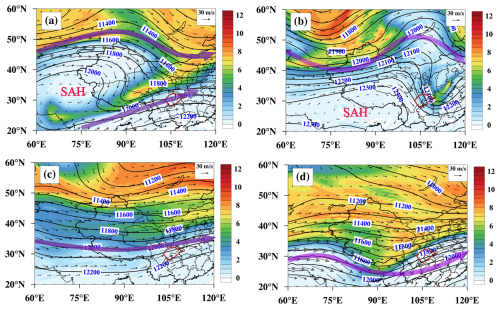
Figure 6Spatial distribution of geopotential height (in gpm; black lines), wind vectors and potential vorticity (units in PVU, 10−6 m2 s−1 K kg−1; color shaded) with subtropical westerly jet (purple lines with arrows) at 200 hPa during (a) 15 April, (b) 1 July, (c) 26 October and (d) 28 January in 2017. The SAH indicates the South Asian High in the upper troposphere, and the red contour mark the SCB-region.
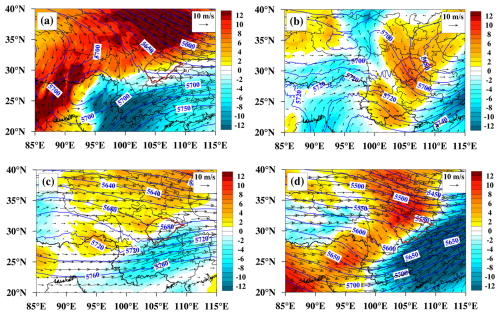
Figure 7Geopotential height (in gpm; blue contours), wind vectors and vertical velocity (pa s−1; shaded contours) at 500 hPa on (a) 16 April, (b) 1 July, (c) 26 October and (d) 29 January 2017. Positive values of vertical velocity denote subsidence.
In addition, the subtropical westerly jet provides the atmospheric circulation background for the tropopause folding to trigger the SI of O3 over the TP. Attributed to TP's location in the mid-latitude region, southward movement of subtropical westerly jet prevails over the TP in the wintertime, which intensifies tropopause disturbance (Sprenger et al., 2003), leading to frequent SI occurrence over the TP and its surrounding regions (Chen et al., 2011). Westerlies are seasonally strengthened from autumn to winter over the TP region with the southernward shift of the subtropical jet, which is reflected with the stronger westerlies in EP4 than those in EP3 forming a significant zonal structure of tropopause folding over the TP region (Fig. 6c and d), with a high-value region of potential vorticity at 200 hPa approximately with 4–7 PVU. These results reveal the seasonal patterns of atmospheric circulation triggering the SI over the TP hotspot region from large-scale anticyclonic circulation in the warm season to the subtropical jet in the cold season. It is worth noting that the anomalously high levels of potential vorticity appear in most regions over 40° N, which is ascribed to the combination of zonal distribution of atmospheric tropopause heights and seasonal subtropical westerly jet stream shifts.
3.2.2 Stratospheric O3 transport from free troposphere to near-surface atmosphere
Accompanied by high-level O3 of SI entering the middle troposphere, the subsidence momentum at the eastern slope of TP keeps downward transport into the lower troposphere over the SCB. Figure 7 shows that a similar atmospheric circulation pattern is manifested at 500 hPa during SI episodes with propagation of ridge and trough from the upper troposphere (Fig. 6). In EP1 and EP2, deepened geopotential ridges steer high-latitude cold air southward intrusion with intense subsidence in the middle-level troposphere of SCB. Whereas during the periods of EP3 and EP4 episodes, relatively straight free-troposphere westerlies are forcedly elevated at the windward slope of western TP region, while sinking airflows occur at the leeside slope of plateau over the eastern TP and downstream SCB due to the mechanical forcing of TP's large topography. That is, although there is a significant seasonal discrepancy in atmospheric circulation in the middle and upper troposphere, rich O3 originating from SI is inevitably injected into the lower troposphere over SCB through the coupling effects of atmospheric vertical movements under the distinctive terrain forcing of TP.
The regional atmospheric structure over SCB is strongly subject to downdraft at TP's leeside slope (Xu et al., 2016; Shu et al., 2022), where vertical circulation configuration is characterized by the free-troposphere downdraft westerlies and easterly Asian monsoon within the atmospheric boundary layer, constructing a large-scale vertical wind shear and vertical vortices (Ning et al., 2019; Shu et al., 2021). The interaction of regional circulations is conducive to cross-layer exchanges of air pollutants over the SCB (Shu et al., 2023). Figure 8 shows the lower-troposphere vertical circulation patterns with their impacts on the downward transport of SI to the near-surface layer in SCB. Subsidence momentum dominates the SCB region driving high levels of O3 in the middle troposphere to expand into the near-surface atmosphere, with a remarkable vertical O3 difference from the height of 5 km to the near-surface layers of approximately 20 ppb.
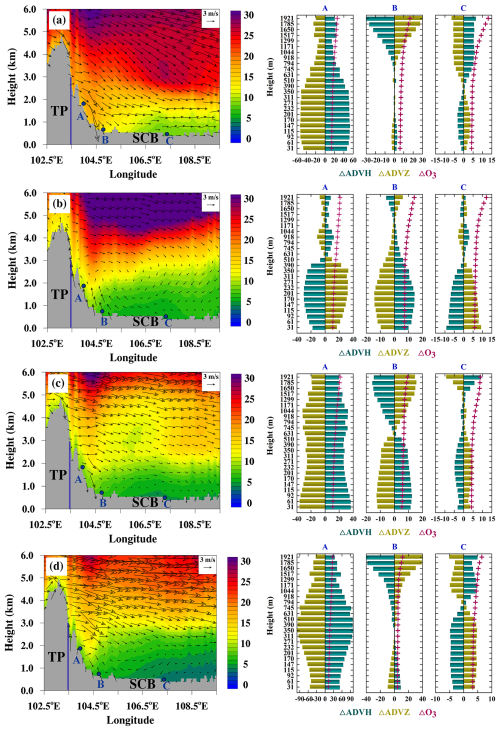
Figure 8Height-longitude cross-sections of O3 (ppb, color contours) and wind vectors averaged between 28 and 33° N on (a) 16 April, (b) 1 July, (c) 26 October and (d) 29 January 2017 (left panel) with correspondingly IPR on horizontal transport (ADVH) and vertical transport (ADVZ) respectively at points A (plateau region), B (western edge of SCB) and C (central SCB). The blue lines roughly outline TP's boundary.
There are two primary intrusion pathways directly and indirectly affecting air quality in the SCB for SI O3-rich airflows (Fig. 8). The direct SI pathway is vertically downwind injection of O3 from the free troposphere into atmospheric boundary layer, which is related to entrainment at the top of boundary layer (Škerlak et al., 2019), mainly over the central and eastern regions of SCB. In comparison, the indirect strtopsheric O3 intrusion over the TP occurs with the slant transport pathway in the troposphere from the TP along the plateau-basin downslope into the western SCB. It is a quasi-horizontal transport process within the atmospheric boundary layer from the high-altitude eastern TP to western SCB, which results in a discernible horizontal gradient of O3 expansion to the west of SCB (Fig. 4). Consistent with these patterns, IPR analysis further confirms that horizontal transport dominates O3 changes over the plateau-basin transition zone in western SCB, whereas vertical transport drives near-surface O3 increases over the flat central and eastern regions during SI episodes. Notably, the dominant transport pathway exhibits significant seasonal variability: the direct intrusion pathway prevails during the warm-season episodes EP2 and EP3, while the indirect pathway dominates during the cold-season episodes EP1 and EP4. This seasonal shift underscores the modulation of TP's topography on SI-induced O3 pollution over the SCB with atmospheric circulation variations.
Another notable feature is Asian Monsoon circulation with intensified easterly wind vectors over the SCB in both EP2 and EP4, facilitating cross-layer transport of SI O3 by vertical vortex in EP2 and EP4 below the heights of 3 and 2 km (a.s.l.). These mechanisms highlight the pivotal role of the plateau-basin topography in regulating the O3 transport from free troposphere to the boundary layer during SI events. The thermodynamic forcing of this topography enhances both vertical and horizontal exchange between the free troposphere and atmospheric boundary layer, critically affecting the seasonal variations of stratospheric O3 intrusion.
3.2.3 The role of deep-basin structure in SI into ambient atmosphere
Based on the terrain sensitivity experiments (O3basin = EXPterr − EXPstro3+terr), we have further investigated the effect of deep-basin terrain on SI-induced near-surface O3 increments. The results of O3basin are mainly analyzed on cross-layer O3 transport from the free troposphere to the near-surface atmosphere during SI episodes. We found that the low-lying basin of SCB can mitigate O3 pollution derived from SIs compared to the idealized experiments with basin-filling terrain. As shown in Fig. S5, westerlies straightly penetrate the regional atmospheric boundary layer of SCB region with stronger quasi-horizontal transboundary transport of TP's rich stratospheric O3. It would aggravate SI-induced O3 enhancements over the SCB's ambient atmosphere, with averages of 9.1 ppb (EP1), 7.8 ppb (EP2), 6.6 ppb (EP3) and 8.0 ppb (EP4), respectively corresponding to the increments of 44.4 %, 41.8 %, 53.5 % and 158.1 % compared to real deep-basin topography. These results illustrate that TP modulates stratospheric O3 transport between the free troposphere and ambient atmosphere while the deep-basin structure of SCB varies O3 transport patterns over the region, revealing an essential terrain-forced mechanism of large plateau-basin topography on cross-layer SI transport.
Aiming at the global SI hotspot TP (Škerlak et al., 2014) and adjoining typical polluted SCB regions, multiple-source meteorology-environment observational and reanalysis data coupled with WRF-Chem simulations are employed to quantify the impacts of stratospheric O3 intrusion on the near-surface ambient atmosphere over SCB in the study. Four SI episodes are targeted to investigate multi-scale atmospheric circulation coupling mechanisms and their seasonality on cross-layer transport of stratospheric O3 under distinctive plateau-basin terrain forcing. Results can deepen the understanding of regional O3 pollution genesis with the exceptional contribution of natural sources derived from the stratosphere.
The occurrence of SI in the TP and surrounding regions exerts a non-negligible impact on aggravating near-surface O3 levels over the downstream SCB, which is primarily characterized by the horizontal expansion of SI-derived O3 levels from the west edge of SCB to the central region. Such downward O3 transport contributes an average increase of ∼ 8.0 ppb, contributing ∼ 38.7 % of environmental changes in the SCB. Larger SI-induced near-surface O3 increments appear during EP1 and EP2 episodes respectively in April and July, providing an extra contribution of 11.1 %–16.0 % to regional O3 pollution formation over the SCB. The results reveal the cross-layer O3 transport affecting air quality from stratosphere to the free troposphere and ultimately into atmospheric boundary layer.
Whereafter, we explore seasonal terrain-forcing atmospheric circulation coupling mechanisms on cross-layer O3 transport. Figure 9 summarizes the primary triggering effects as follows: the unique plateau's thermodynamic forcing in warm seasons but mechanical forcing in the cold season respectively modulates stratospheric O3-rich air injection into the near-surface atmosphere over the SCB affecting regional air quality. On one hand, the joint thermal forcing of TP and Iranian Plateau in EP1 and EP2 triggers stratospheric O3 intrusion over the TP and surrounding regions by peripheral subsidence of South Asian High in the upper troposphere. Stratospheric O3 is steered by intensified zonal interaction of westerlies driving high-latitude cold airflows downward transport into the adjacent SCB region. On the other hand, the southward retreat of the subtropical jet stream during the EP3 and EP4 leads to SIs occurrence over the TP (Chen et al., 2011; Luo et al., 2019). With the TP's mechanical forcing on stronger middle-troposphere westerlies, leeward slope subsidence delivers high-level stratospheric O3 to the lower troposphere over the SCB region.
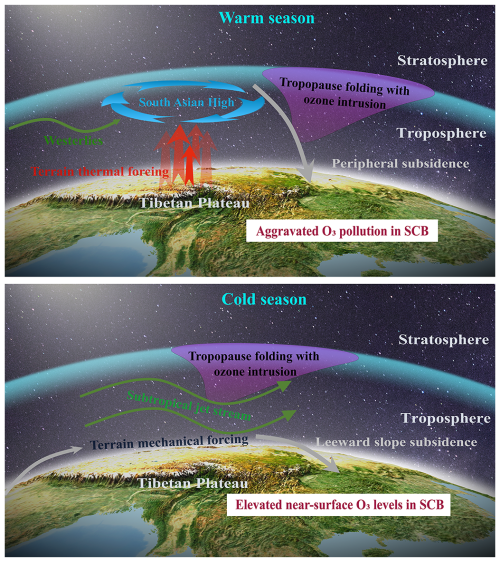
Figure 9Diagram on the cross-layer transport of stratospheric O3 on regional atmospheric environmental changes over SCB driven by mult-scale atmospheric circulation pattern with the seasonally discrepant terrain effects of TP.
Two primary pathways are identified to affect air quality over the SCB for SI-derived O3, involving along the TP's downslope into the western SCB and direct downwind transport into atmospheric boundary layer over the central and eastern regions of SCB. A direct intrusion pathway prevails during the warm-season episodes EP2 and EP3, while the indirect pathway dominates during the cold-season episodes EP1 and EP4 driven by the topography effects of TP on SI-induced O3 pollution aggravation over the SCB. The existence of low-lying deep basin structure weakens the contribution of SI to ambient atmosphere in the SCB.
This modeling study investigates the four episodes for a seasonal assessment of the contribution of stratospheric O3 intrusion to the SCB regions in Southwest China, highlighting the multi-scale atmospheric circulation coupling mechanisms under the distinctive plateau-basin terrain forcing. In the future, it is necessary to generalize the climatology of SI impacts on the near-surface environmental atmosphere in the region with multi-year observations and simulations.
The ground-based environment and meteorology data are respectively available at the China National Environmental Monitoring Center (http://www.cnemc.cn/, last access: 5 November 2025) and the Chinese Meteorological Monitoring Network (http://data.cma.cn/, last access: 5 November 2025). ERA5 data are derived from Copernicus Climate Change Service (C3S) Climate Date Store (https://cds.climate.copernicus.eu/datasets, last access: 5 November 2025). EAC4 reanalysis data are obtained from Copernicus Atmosphere Monitoring Service (https://ads.atmosphere.copernicus.eu/datasets, last access: 5 November 2025). All data used in this paper can be provided upon request from Zhuozhi Shu (shuzhuozhi@foxmail.com).
The supplement related to this article is available online at https://doi.org/10.5194/acp-25-15437-2025-supplement.
Conceptualization: ZS, TZ, FY, GS, YZ. Investigation: ZS, YH, XY, BP. Methodology: ZS, TZ, YZ. Validation: YH, XY, BP. Writing (original draft preparation): ZS, TZ, YZ. Writing (review and editing): ZS, TZ, YZ, FY, GS. All of the authors provided commentary on the paper.
The contact author has declared that none of the authors has any competing interests.
Publisher’s note: Copernicus Publications remains neutral with regard to jurisdictional claims made in the text, published maps, institutional affiliations, or any other geographical representation in this paper. While Copernicus Publications makes every effort to include appropriate place names, the final responsibility lies with the authors. Views expressed in the text are those of the authors and do not necessarily reflect the views of the publisher.
We are grateful to the study participants and the anonymous reviewers for their constructive suggestions.
This work was supported jointly by the National Natural Science Foundation of China (grant nos. 42405195 and 42275196), the National Key Research and Development Program of China (grant nos. 2022YFC3701204 and 2023YFC3709301) and the National Natural Science Foundation of China (grant nos. 42207134 and 42465008).
This paper was edited by Leiming Zhang and reviewed by two anonymous referees.
Barth, M. C., Lee, J., Hodzic, A., Pfister, G., Skamarock, W. C., Worden, J., Wong, J., and Noone, D.: Thunderstorms and upper troposphere chemistry during the early stages of the 2006 North American Monsoon, Atmos. Chem. Phys., 12, 11003–11026, https://doi.org/10.5194/acp-12-11003-2012, 2012.
Bracci, A., Cristofanelli, P., Sprenger, M., Bonafè, U., Calzolari, F., Duchi, R., Laj, P., Marinoni, A., Roccato, F., Vuillermoz, E., and Bonasoni, P.: Transport of Stratospheric Air Masses to the Nepal Climate Observatory–Pyramid (Himalaya; 5079 m MSL): A Synoptic-Scale Investigation, J. Appl. Meteorol. Clim., 51, 1489–1507, https://doi.org/10.1175/JAMC-D-11-0154.1, 2012.
Brewer, A. W.: Evidence for a world circulation provided by the measurements of helium and water vapour distribution in the stratosphere, Q. J. Roy. Meteor. Soc., 75, 351–363, https://doi.org/10.1002/qj.49707532603, 1949.
Butchart, N.: The Brewer-Dobson circulation, Rev. Geophys., 52, 157–184, https://doi.org/10.1002/2013RG000448, 2014.
Chen, X. L., Ma, Y. M., Kelder, H., Su, Z., and Yang, K.: On the behaviour of the tropopause folding events over the Tibetan Plateau, Atmos. Chem. Phys., 11, 5113–5122, https://doi.org/10.5194/acp-11-5113-2011, 2011.
Chen, Z., Liu, J., Cheng, X., Yang, M., and Shu, L.: Stratospheric influences on surface ozone increase during the COVID-19 lockdown over northern China, npj Clim. Atmos. Sci., 6, 76, https://doi.org/10.1038/s41612-023-00406-2, 2023.
Chou, Y., Huang, Q., Zhang, Yongpeng, Luo, J., Wang, M., Liao, H., Zhang, Y., and Bai, Z.: Impacts of deep boundary layer on near-surface ozone concentration over the Tibetan Plateau, Atmos. Environ., 294, 119532, https://doi.org/10.1016/j.atmosenv.2022.119532, 2023.
Ding, A. and Wang, T.: Influence of stratosphere-to-troposphere exchange on the seasonal cycle of surface ozone at Mount Waliguan in western China, Geophys. Res. Lett., 33, L03803, https://doi.org/10.1029/2005GL024760, 2006.
Dobson, G. M. B.: Origin and distribution of the polyatomic molecules in the atmosphere, Proc. Roy. Soc. Lond. A, 236, 187–193, https://doi.org/10.1098/rspa.1956.0127, 1956.
Emery, C. A., Tai, E., and Yarwood, G.: Enhanced Meteorological Modeling and Performance Evaluation for Two Texas Ozone Episodes, Prepared for the Texas Natural Resource Conservation Commission, by Environ International Corp, https://api.semanticscholar.org/CorpusID:127579774 (last access: 5 November 2025), 2001.
Feng, Z., Hu, E., Wang, X., Jiang, L., and Liu, X.: Ground-level O3 pollution and its impacts on food crops in China: A review, Environ. Pollut., 199, 42–48, https://doi.org/10.1016/j.envpol.2015.01.016, 2015.
Fiore, A. M., Jacob, D. J., Field, B. D., Streets, D. G., Fernandes, S. D., and Jang, C.: Linking ozone pollution and climate change: The case for controlling methane, Geophys. Res. Lett., 29, 25-1–25-4, https://doi.org/10.1029/2002GL015601, 2002.
Fu, R., Hu, Y., Wright, J. S., Jiang, J. H., Dickinson, R. E., Chen, M., Filipiak, M., Read, W. G., Waters, J. W., and Wu, D. L.: Short circuit of water vapor and polluted air to the global stratosphere by convective transport over the Tibetan Plateau, P. Natl. Acad. Sci. USA, 103, 5664–5669, https://doi.org/10.1073/pnas.0601584103, 2006.
Gao, M., Gao, J., Zhu, B., Kumar, R., Lu, X., Song, S., Zhang, Y., Jia, B., Wang, P., Beig, G., Hu, J., Ying, Q., Zhang, H., Sherman, P., and McElroy, M. B.: Ozone pollution over China and India: seasonality and sources, Atmos. Chem. Phys., 20, 4399–4414, https://doi.org/10.5194/acp-20-4399-2020, 2020.
Guenther, A. B., Jiang, X., Heald, C. L., Sakulyanontvittaya, T., Duhl, T., Emmons, L. K., and Wang, X.: The Model of Emissions of Gases and Aerosols from Nature version 2.1 (MEGAN2.1): an extended and updated framework for modeling biogenic emissions, Geosci. Model Dev., 5, 1471–1492, https://doi.org/10.5194/gmd-5-1471-2012, 2012.
Hu, J., Zhao, T., Liu, J., Cao, L., Wang, C., Li, Y., Shi, C., Tan, C., Sun, X., Shu, Z., and Li, J.: Exploring the ozone pollution over the western Sichuan Basin, Southwest China: The impact of diurnal change in mountain-plains solenoid, Sci. Total. Environ., 839, 156264, https://doi.org/10.1016/j.scitotenv.2022.156264, 2022.
Huang, J., Zhou, X., Wu, G., Xu, X., Zhao, Q., Liu, Yimin, Duan, A., Xie, Y., Ma, Y., Zhao, P., Yang, S., Yang, K., Yang, H., Bian, J., Fu, Y., Ge, J., Liu, Yuzhi, Wu, Q., Yu, H., and Qie, K.: Global Climate Impacts of Land-Surface and Atmospheric Processes Over the Tibetan Plateau, Rev. Geophys., 61, e2022RG000771, https://doi.org/10.1029/2022RG000771, 2023.
Inness, A., Ades, M., Agustí-Panareda, A., Barré, J., Benedictow, A., Blechschmidt, A.-M., Dominguez, J. J., Engelen, R., Eskes, H., Flemming, J., Huijnen, V., Jones, L., Kipling, Z., Massart, S., Parrington, M., Peuch, V.-H., Razinger, M., Remy, S., Schulz, M., and Suttie, M.: The CAMS reanalysis of atmospheric composition, Atmos. Chem. Phys., 19, 3515–3556, https://doi.org/10.5194/acp-19-3515-2019, 2019.
Kong, L., Zhou, L., Chen, D., Luo, L., Xiao, K., Chen, Y., Liu, H., Tan, Q., and Yang, F.: Atmospheric oxidation capacity and secondary pollutant formation potentials based on photochemical loss of VOCs in a megacity of the Sichuan Basin, China, Sci. Total. Environ., 901, 166259, https://doi.org/10.1016/j.scitotenv.2023.166259, 2023.
Koumoutsaris, S., Bey, I., Generoso, S., and Thouret, V.: Influence of El Niño–Southern Oscillation on the interannual variability of tropospheric ozone in the northern midlatitudes, J. Geophys. Res.-Atmos., 113, D19301, https://doi.org/10.1029/2007JD009753, 2008.
Lamarque, J.-F., Emmons, L. K., Hess, P. G., Kinnison, D. E., Tilmes, S., Vitt, F., Heald, C. L., Holland, E. A., Lauritzen, P. H., Neu, J., Orlando, J. J., Rasch, P. J., and Tyndall, G. K.: CAM-chem: description and evaluation of interactive atmospheric chemistry in the Community Earth System Model, Geosci. Model Dev., 5, 369–411, https://doi.org/10.5194/gmd-5-369-2012, 2012.
Lee, J., Wu, Y., and Wang, X.: The evolutions and large-scale mechanisms of summer stratospheric ozone intrusion across global hotspots, J. Geophys. Res.-Atmos., 129, e2023JD039877, https://doi.org/10.1029/2023JD039877, 2024.
Li, D., Vogel, B., Müller, R., Bian, J., Günther, G., Li, Q., Zhang, J., Bai, Z., Vömel, H., and Riese, M.: High tropospheric ozone in Lhasa within the Asian summer monsoon anticyclone in 2013: influence of convective transport and stratospheric intrusions, Atmos. Chem. Phys., 18, 17979–17994, https://doi.org/10.5194/acp-18-17979-2018, 2018.
Lin, M., Fiore, A. M., Cooper, O. R., Horowitz, L. W., Langford, A. O., Levy II, H., Johnson, B. J., Naik, V., Oltmans, S. J., and Senff, C. J.: Springtime high surface ozone events over the western United States: Quantifying the role of stratospheric intrusions, J. Geophys. Res.-Atmos., 117, D00V22, https://doi.org/10.1029/2012JD018151, 2012.
Lin, M., Fiore, A. M., Horowitz, L. W., Langford, A. O., Oltmans, S. J., Tarasick, D., and Rieder, H. E.: Climate variability modulates western US ozone air quality in spring via deep stratospheric intrusions, Nat. Commun., 6, 7105, https://doi.org/10.1038/ncomms8105, 2015.
Liu, J., Strode, S. A., Liang, Q., Oman, L. D., Colarco, P. R., Fleming, E. L., Manyin, M. E., Douglass, A. R., Ziemke, J. R., Lamsal, L. N., and Li, C.: Change in Tropospheric Ozone in the Recent Decades and Its Contribution to Global Total Ozone, J. Geophys. Res.-Atmos., 127, e2022JD037170, https://doi.org/10.1029/2022JD037170, 2022.
Lu, X., Hong, J., Zhang, L., Cooper, O. R., Schultz, M. G., Xu, X., Wang, T., Gao, M., Zhao, Y., and Zhang, Y.: Severe Surface Ozone Pollution in China: A Global Perspective, Environ. Sci. Technol. Lett., 5, 487–494, https://doi.org/10.1021/acs.estlett.8b00366, 2018.
Luo, J., Liang, W., Xu, P., Xue, H., Zhang, M., Shang, L., and Tian, H.: Seasonal Features and a Case Study of Tropopause Folds over the Tibetan Plateau, Adv. Meteorol., 2019, 1–12, https://doi.org/10.1155/2019/4375123, 2019.
Ma, J., Lin, W. L., Zheng, X. D., Xu, X. B., Li, Z., and Yang, L. L.: Influence of air mass downward transport on the variability of surface ozone at Xianggelila Regional Atmosphere Background Station, southwest China, Atmos. Chem. Phys., 14, 5311–5325, https://doi.org/10.5194/acp-14-5311-2014, 2014.
Miri, M., Derakhshan, Z., Allahabadi, A., Ahmadi, E., Oliveri Conti, G., Ferrante, M., and Aval, H. E.: Mortality and morbidity due to exposure to outdoor air pollution in Mashhad metropolis, Iran. The AirQ model approach, Environ. Res., 151, 451–457, https://doi.org/10.1016/j.envres.2016.07.039, 2016.
Monks, P. S., Archibald, A. T., Colette, A., Cooper, O., Coyle, M., Derwent, R., Fowler, D., Granier, C., Law, K. S., Mills, G. E., Stevenson, D. S., Tarasova, O., Thouret, V., von Schneidemesser, E., Sommariva, R., Wild, O., and Williams, M. L.: Tropospheric ozone and its precursors from the urban to the global scale from air quality to short-lived climate forcer, Atmos. Chem. Phys., 15, 8889–8973, https://doi.org/10.5194/acp-15-8889-2015, 2015.
Naik, V., Voulgarakis, A., Fiore, A. M., Horowitz, L. W., Lamarque, J.-F., Lin, M., Prather, M. J., Young, P. J., Bergmann, D., Cameron-Smith, P. J., Cionni, I., Collins, W. J., Dalsøren, S. B., Doherty, R., Eyring, V., Faluvegi, G., Folberth, G. A., Josse, B., Lee, Y. H., MacKenzie, I. A., Nagashima, T., van Noije, T. P. C., Plummer, D. A., Righi, M., Rumbold, S. T., Skeie, R., Shindell, D. T., Stevenson, D. S., Strode, S., Sudo, K., Szopa, S., and Zeng, G.: Preindustrial to present-day changes in tropospheric hydroxyl radical and methane lifetime from the Atmospheric Chemistry and Climate Model Intercomparison Project (ACCMIP), Atmos. Chem. Phys., 13, 5277–5298, https://doi.org/10.5194/acp-13-5277-2013, 2013.
Neu, J. L., Flury, T., Manney, G. L., Santee, M. L., Livesey, N. J., and Worden, J.: Tropospheric ozone variations governed by changes in stratospheric circulation, Nat. Geosci., 7, 340–344, https://doi.org/10.1038/ngeo2138, 2014.
Nieto, R., Gimeno, L., de la Torre, L., Ribera, P., Gallego, D., García-Herrera, R., García, J.A., Nuñez, M., Redaño, A., and Lorente, J.: Climatological Features of Cutoff Low Systems in the Northern Hemisphere, J. Climate, 18, 3085–3103, https://doi.org/10.1175/JCLI3386.1, 2005.
Ning, G., Yim, S. H. L., Wang, S., Duan, B., Nie, C., Yang, X., Wang, J., and Shang, K.: Synergistic effects of synoptic weather patterns and topography on air quality: a case of the Sichuan Basin of China, Clim. Dynam., 53, 6729–6744, https://doi.org/10.1007/s00382-019-04954-3, 2019.
Pierce, B. and Holloway, T.: When Stratospheric Ozone Hits Ground-level Regulation: Exceptional Events in Wyoming, B. Am. Meteorol. Soc., 98, 889–892, https://doi.org/10.1175/BAMS-D-14-00133.1, 2017.
Shen, L., Liu, J., Zhao, T., Xu, X., Han, H., Wang, H., and Shu, Z.: Atmospheric transport drives regional interactions of ozone pollution in China, Sci. Total. Environ., 830, 154634, https://doi.org/10.1016/j.scitotenv.2022.154634, 2022.
Shu, Z., Liu, Y., Zhao, T., Xia, J., Wang, C., Cao, L., Wang, H., Zhang, L., Zheng, Y., Shen, L., Luo, L., and Li, Y.: Elevated 3D structures of PM2.5 and impact of complex terrain-forcing circulations on heavy haze pollution over Sichuan Basin, China, Atmos. Chem. Phys., 21, 9253–9268, https://doi.org/10.5194/acp-21-9253-2021, 2021.
Shu, Z., Zhao, T., Chen, Y., Liu, Y., Yang, F., Jiang, Y., He, G., Yang, Q., and Zhang, Y.: Terrain effect on atmospheric process in seasonal ozone variation over the Sichuan Basin, Southwest China, Environ. Pollut., 338, 122622, https://doi.org/10.1016/j.envpol.2023.122622, 2023.
Shu, Z., Zhao, T., Liu, Y., Zhang, L., Ma, X., Kuang, X., Li, Y., Huo, Z., Ding, Q., Sun, X., and Shen, L.: Impact of deep basin terrain on PM2.5 distribution and its seasonality over the Sichuan Basin, Southwest China, Environ. Pollut., 300, 118944, https://doi.org/10.1016/j.envpol.2022.118944, 2022.
Škerlak, B., Sprenger, M., and Wernli, H.: A global climatology of stratosphere–troposphere exchange using the ERA-Interim data set from 1979 to 2011, Atmos. Chem. Phys., 14, 913–937, https://doi.org/10.5194/acp-14-913-2014, 2014.
Škerlak, B., Sprenger, M., Pfahl, S., Tyrlis, E., and Wernli, H.: Tropopause folds in ERA-Interim: Global climatology and relation to extreme weather events, J. Geophys. Res.-Atmos., 120, 4860–4877, https://doi.org/10.1002/2014JD022787, 2015.
Škerlak, B., Pfahl, S., Sprenger, M., and Wernli, H.: A numerical process study on the rapid transport of stratospheric air down to the surface over western North America and the Tibetan Plateau, Atmos. Chem. Phys., 19, 6535–6549, https://doi.org/10.5194/acp-19-6535-2019, 2019.
Sprenger, M., Maspoli, M. C., and Wernli, H.: Tropopause folds and cross-tropopause exchange: A global investigation based upon ECMWF analyses for the time period March 2000 to February 2001, J. Geophys. Res.-Atmos., 108, 8518, https://doi.org/10.1029/2002JD002587, 2003.
Stohl, A., Wernli, H., James, P., Bourqui, M., Forster, C., Liniger, M. A., Seibert, P., and Sprenger, M.: A New Perspective of Stratosphere–Troposphere Exchange, B. Am. Meteorol. Soc., 84, 1565–1574, https://doi.org/10.1175/BAMS-84-11-1565, 2003.
Trickl, T., Bärtsch-Ritter, N., Eisele, H., Furger, M., Mücke, R., Sprenger, M., and Stohl, A.: High-ozone layers in the middle and upper troposphere above Central Europe: potential import from the stratosphere along the subtropical jet stream, Atmos. Chem. Phys., 11, 9343–9366, https://doi.org/10.5194/acp-11-9343-2011, 2011.
Trickl, T., Vogelmann, H., Giehl, H., Scheel, H.-E., Sprenger, M., and Stohl, A.: How stratospheric are deep stratospheric intrusions?, Atmos. Chem. Phys., 14, 9941–9961, https://doi.org/10.5194/acp-14-9941-2014, 2014.
Venkat Ratnam, M., Ravindra Babu, S., Das, S. S., Basha, G., Krishnamurthy, B. V., and Venkateswararao, B.: Effect of tropical cyclones on the stratosphere–troposphere exchange observed using satellite observations over the north Indian Ocean, Atmos. Chem. Phys., 16, 8581–8591, https://doi.org/10.5194/acp-16-8581-2016, 2016.
Wang, H., Wang, W., Huang, X., and Ding, A.: Impacts of stratosphere-to-troposphere-transport on summertime surface ozone over eastern China, Sci. Bull., 65, 276–279, https://doi.org/10.1016/j.scib.2019.11.017, 2020.
Wang, L., Li, M., Wang, Q., Li, Y., Xin, J., Tang, X., Du, W., Song, T., Li, T., Sun, Y., Gao, W., Hu, B., and Wang, Y.: Air stagnation in China: Spatiotemporal variability and differing impact on PM2.5 and O3 during 2013–2018, Sci. Total. Environ., 819, 152778, https://doi.org/10.1016/j.scitotenv.2021.152778, 2022.
Wang, W., Parrish, D. D., Wang, S., Bao, F., Ni, R., Li, X., Yang, S., Wang, H., Cheng, Y., and Su, H.: Long-term trend of ozone pollution in China during 2014–2020: distinct seasonal and spatial characteristics and ozone sensitivity, Atmos. Chem. Phys., 22, 8935–8949, https://doi.org/10.5194/acp-22-8935-2022, 2022.
Wang, N., Du, Y., Chen, D., Meng, H., Chen, X., Zhou, L., Shi, G., Zhan, Y., Feng, M., Li, W., Chen, M., Li, Z., and Yang, F.: Spatial disparities of ozone pollution in the Sichuan Basin spurred by extreme, hot weather, Atmos. Chem. Phys., 24, 3029–3042, https://doi.org/10.5194/acp-24-3029-2024, 2024.
Wang, Y., He, Y., Sheng, Z., Sun, J., Qin, Z., and Tao, Y. Vertical ozone transport by Rossby wave breaking in upper troposphere-lower stratosphere is weakening, Atmos. Environ., 343, 120999, https://doi.org/10.1016/j.atmosenv.2024.120999, 2025.
Waugh, D. W. and Polvani, L. M.: Climatology of intrusions into the tropical upper troposphere, Geophys. Res. Lett., 27, 3857–3860, https://doi.org/10.1029/2000GL012250, 2000.
Wei, J., Li, Z., Li, K., Dickerson, R. R., Pinker, R. T., Wang, J., Liu, X., Sun, L., Xue, W., and Cribb, M.: Full-coverage mapping and spatiotemporal variations of ground-level ozone (O3) pollution from 2013 to 2020 across China, Remote Sens. Environ., 270, 112775, https://doi.org/10.1016/j.rse.2021.112775, 2022.
Wei, J., Ren, J., Li, J., and Xie, S.: Characteristics and drivers of springtime ozone pollution in the Sichuan Basin, China, in May 2020 and 2024, Atmos. Environ., 361, 121476, https://doi.org/10.1016/j.atmosenv.2025.121476, 2025.
Williams, R. S., Hegglin, M. I., Kerridge, B. J., Jöckel, P., Latter, B. G., and Plummer, D. A.: Characterising the seasonal and geographical variability in tropospheric ozone, stratospheric influence and recent changes, Atmos. Chem. Phys., 19, 3589–3620, https://doi.org/10.5194/acp-19-3589-2019, 2019.
Xian, Y., Zhang, Y., Liu, Z., Wang, H., Wang, J., and Tang, C.: Source apportionment and formation of warm season ozone pollution in Chengdu based on CMAQ-ISAM, Urban Climate, 56, 102017, https://doi.org/10.1016/j.uclim.2024.102017, 2024.
Xu, X., Zhao, T., Liu, F., Gong, S. L., Kristovich, D., Lu, C., Guo, Y., Cheng, X., Wang, Y., and Ding, G.: Climate modulation of the Tibetan Plateau on haze in China, Atmos. Chem. Phys., 16, 1365–1375, https://doi.org/10.5194/acp-16-1365-2016, 2016.
Xu, T., Gao, X., Jiang, S., Hu, K., Peng, Z., Zhao, X., and Tang, X.: Nonlinear ozone response to extreme high temperature in a subtropical megacity basin: Integrated observation and modeling analysis, Environ. Res., 285, 122274, https://doi.org/10.1016/j.envres.2025.122274, 2025.
Yang, J., Wang, K., Lin, M., Yin, X., and Kang, S.: Not biomass burning but stratospheric intrusion dominating tropospheric ozone over the Tibetan Plateau, P. Natl. Acad. Sci. USA., 119, e2211002119, https://doi.org/10.1073/pnas.2211002119, 2022.
Yang, X., Wu, K., Wang, H., Liu, Y., Gu, S., Lu, Y., Zhang, X., Hu, Y., Ou, Y., Wang, S., and Wang, Z.: Summertime ozone pollution in Sichuan Basin, China: Meteorological conditions, sources and process analysis, Atmos. Environ., 226, 117392, https://doi.org/10.1016/j.atmosenv.2020.117392, 2020.
Yang, Q., Zhao, T., Bai, Y., Meng, K., Luo, Y., Tian, Z., Sun, X., Fu, W., Yang, K., and Hu, J.: Distinct structures of interannual variations in stratosphere-to-troposphere ozone transport induced by the Tibetan Plateau thermal forcing, Atmos. Chem. Phys., 25, 8029–8042, https://doi.org/10.5194/acp-25-8029-2025, 2025.
Yin, X., Kang, S., de Foy, B., Cong, Z., Luo, J., Zhang, L., Ma, Y., Zhang, G., Rupakheti, D., and Zhang, Q.: Surface ozone at Nam Co in the inland Tibetan Plateau: variation, synthesis comparison and regional representativeness, Atmos. Chem. Phys., 17, 11293–11311, https://doi.org/10.5194/acp-17-11293-2017, 2017.
Yin, X., Rupakheti, D., Zhang, G., Luo, J., Kang, S., de Foy, B., Yang, J., Ji, Z., Cong, Z., Rupakheti, M., Li, P., Hu, Y., and Zhang, Q.: Surface ozone over the Tibetan Plateau controlled by stratospheric intrusion, Atmos. Chem. Phys., 23, 10137–10143, https://doi.org/10.5194/acp-23-10137-2023, 2023.
Zhang, L., Guo, X., Zhao, T., Gong, S., Xu, X., Li, Y., Luo, L., Gui, K., Wang, H., Zheng, Y., and Yin, X.: A modelling study of the terrain effects on haze pollution in the Sichuan Basin, Atmos. Environ., 196, 77–85, https://doi.org/10.1016/j.atmosenv.2018.10.007, 2019.
Zhang, M., Tian, W., Chen, L., and Lü, D.: Cross-tropopause mass exchange associated with a tropopause fold event over the northeastern Tibetan Plateau, Adv. Atmos. Sci., 27, 1344–1360, https://doi.org/10.1007/s00376-010-9129-9, 2010.
Zhang, Y., Li, J., Yang, W., Du, H., Tang, X., Ye, Q., Wang, Z., Sun, Y., Pan, X., Zhu, L., and Wang, Z.: Influences of stratospheric intrusions to high summer surface ozone over a heavily industrialized region in northern China, Environ. Res. Lett., 17, 094023, https://doi.org/10.1088/1748-9326/ac8b24, 2022.
Zhao, K., Huang, J., Wu, Y., Yuan, Z., Wang, Yongwei, Li, Y., Ma, X., Liu, X., Ma, W., Wang, Y., and Zhang, X.: Impact of Stratospheric Intrusions on Ozone Enhancement in the Lower Troposphere and Implication to Air Quality in Hong Kong and Other South China Regions, J. Geophys. Res.-Atmos., 126, e2020JD033955, https://doi.org/10.1029/2020JD033955, 2021.





